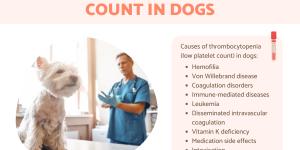Leukopenia in Dogs - Low White Blood Cell Count



See files for Dogs
To better understand leukopenia in dogs, we need to understand the makeup of a dog's blood. Blood is part liquid, part cellular. The liquid part is known as plasma and contains fibrinogen and serum. The cellular part is made up of erythrocytes (red blood cells), leukocytes (white blood cells) and thrombocytes (platelets). The main function of the blood is the transportation of substances. These include essential substances for survival of the organism such as oxygen, carbon dioxide, nutrients and hormones, as well as undesirable products of metabolism for the organism that are taken to the organs of excretion[1].
At AnimalWised we look at leukopenia in dogs, a condition characterized by a low white blood cell count. It is diagnosed by a leukogram, a part of a complete blood count test. We look in detail at the causes, symptoms and treatment of a low white blood cell count in dogs.
What is leukopenia in dogs?
Leukopenia is defined as low leukocyte levels in dogs, i.e. a low white blood cell count. Blood is responsible for the homeostasis (healthy balance of the organism's systems) of dogs. A blood count will provide information that can be used as a tool to help the veterinarian make a diagnosis, along with clinical signs and other tests.
Leukocytes are produced in the bone marrow from a pluripotent cell, also called a stem cell. The leukogram is the part of the blood count that evaluates leukocytes, allowing the evaluation of infectious processes caused by viruses, bacteria, parasitic infections or allergic processes, among other pathologies. Several types of leukocytes are analyzed in the leukogram:
- Neutrophils: responsible for protection against bacterial infections.
- Eosinophils: responsible for defense against parasites and allergic reactions.
- Basophils: combat allergic and parasitic processes.
- Lymphocytes: responsible for the production of antibodies.
- Monocytes: carry out the process of phagocytosis of microorganisms and destruction of dead cells.
Leukopenia in dogs occurs when the number of leukocytes is below the indicated level for a healthy dog. Since white blood cells are partly responsible for their immune response, a low leukocyte count in dogs can make them vulnerable to serious viral and bacterial infections. Leukopenia is also associated with neutropenia (decreased neutrophils) and lymphopenia (decreased lymphocytes), and can also reduce the number of other white blood cells.
Causes of leukopenia in dogs
Leukopenia is mainly caused by neutropenias (a decrease in the normal number of neutrophils, one of the types of white blood cells), which can occur in four ways :
- Reduced survival of mature neutrophils: occurs when the demand for neutrophils in the body's tissues is acute and massive, rapidly depleting the blood supply of these cells. If the need is great and lasts for a prolonged time, the neutrophil pool may be depleted and production in the bone marrow becomes insufficient.
- Reduced production in the bone marrow: is associated with primary bone marrow failure. Other cell lines may also be affected. Some known causes are infections (canine parvovirus and canine ehrlichiosis) and as a consequence of certain drugs (trimethoprim, phenylbutazone, estrogens, chemotherapeutic agents), as well as potential genetic causes[2].
- Inefficient production: an immune-mediated depletion of neutrophils can occur whereby the cells produced will be destroyed soon after. This means they do not enable their protective role in the body.
- Sequestration neutropenia: occurs with anaphylactic shock in dogs and endotoxemia, causing an aggregation and sequestration of neutrophils and platelets in the pulmonary capillaries.
In a more general sense, leukopenia in dogs can be caused by:
- Viral diseases
- Hereditary condition
- Serious bacterial infection
- Anaphylaxis
- Drugs and toxic chemicals
- Bone marrow tumors
- Endogenous toxemia (toxins produced in the body)
- Uremia (high levels of urea in blood)
- Toxoplasmosis
- Ehrlichiosis
- Leishmaniasis
A low white blood cell count in dogs is not the only consequence of these pathologies. Find out about other affects of some of these diseases with our article on leishmaniasis in dogs.
Symptoms of leukopenia in dogs
The symptoms of low leukocytes in dogs will depend on the underlying cause. Leukopenia itself is not a disease, but the result of the body fighting some external aggression or a decrease in the production of cells by the bone marrow.
Taking this into account, a dog with leukopenia can present varied symptoms. For example, if the cause is canine leishmaniasis, the dog will experience hair loss, non-healing wounds, overgrowth of nails, etc. If the reason is a viral disease, the associated signs will depend on the virus causing the pathology.
Learn about a similar issue with a dog's blood count with our article on lymphopenia in dogs.

How to treat leukopenia in dogs
Treatment will depend according to the disease causing leukopenia in dogs. The dog must be examined by a veterinarian, who will request additional tests to diagnose said pathology. It is only they who can prescribe the most appropriate treatment.
In some cases, we can use immunomodulators. These are substances that act on the immune system, increasing the organic response against certain microorganisms These include viruses, bacteria and protozoa. Immunomodulators can include pharmacological substances and microbial products, as well as certain plant sources, although further research is required to achieve conclusive results on the effects of the latter[3].
For use in veterinary medicine, some immunomodulators include interferons, interleukins, bacillus Calmette and Guérin (BCG) and its derivatives, Cutibacterium acnes, mixed bacterial vaccine, PIND-ORF, Phosprenyl, Quillaja saponis, Bordetella pertussis, avridine and levamisole.
Diet for dogs with leukopenia
In addition to immunomodulators, food is a very important factor in maintaining and increasing the dog's immunity and is usually included in the treatment for leukopenia in dogs. As with human's a dog's nutrition will have a direct effect on their health. There are different foods which can help maintain health and build a white blood cell count, although not all are foods suitable for humans.
What is important to note is a low leukocyte count cannot be treated at home without the veterinarian's express permission. If a dog has a low white blood cell count due to a serious infection such as parvovirus or as a result of drug toxicity, treatment with diet will be insufficient and can result in the death of the animal. Balanced nutrition and sufficient exercise will help help a dog to maintain overall health which includes health white blood cell production. It does not replace specific treatment administration for many of the causes of leukopenia in dogs.
Learn more about diagnosing canine disease with our article on how to understand a dog's blood test.
This article is purely informative. AnimalWised does not have the authority to prescribe any veterinary treatment or create a diagnosis. We invite you to take your pet to the veterinarian if they are suffering from any condition or pain.
If you want to read similar articles to Leukopenia in Dogs - Low White Blood Cell Count, we recommend you visit our Other health problems category.
1. Lopes, S. T. A., Biondo, A. W., & Santos, A. P. (2007). Manual of Veterinary Clinical Pathology. Federal University of Santa Maria. Retrieved from: https://www.bibliotecaagptea.org.br/zootecnia/sanidade/livros/MANUAL%20DE%20PATOLOGIA%20CLINICA%20VETERINARIA.pdf.
2. Gommeren, K., Duchateau, L., Paepe, D., Vanholen, L., Vandenberghe, A., & Daminet, S. (2006). Investigation of physiologic leukopenia in Belgian Tervuren dogs. Journal of veterinary internal medicine, 20(6), 1340–1343.
https://doi.org/10.1892/0891-6640(2006)20[1340:ioplib]2.0.co;2
3. Catanzaro, M., Corsini, E., Rosini, M., Racchi, M., & Lanni, C. (2018). Immunomodulators Inspired by Nature: A Review on Curcumin and Echinacea. Molecules (Basel, Switzerland), 23(11), 2778. https://doi.org/10.3390/molecules23112778
- Appolinario, C. M., & Megid, J. (2007). Use of immunomodulators in infectious diseases of domestic animals. Agricultural Sciences Seminar, Londrina, 28(3), 437-448. Retrieved from: https://pesquisa.bvsalud.org/portal/resource/pt/lil-481183.






